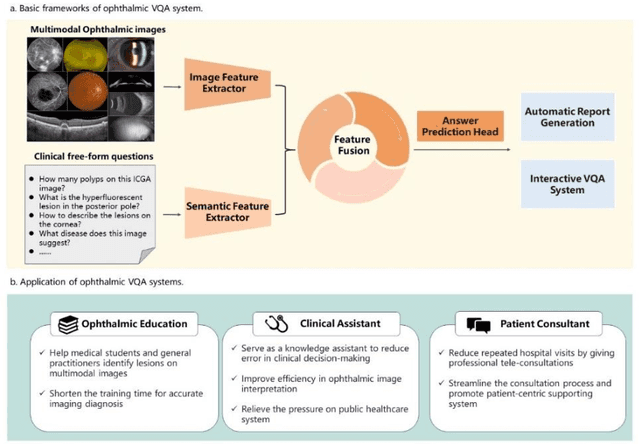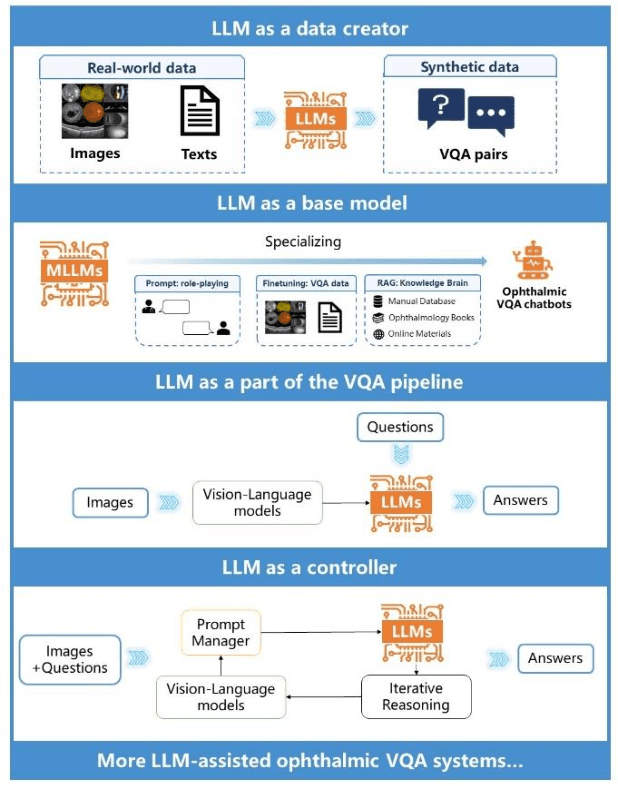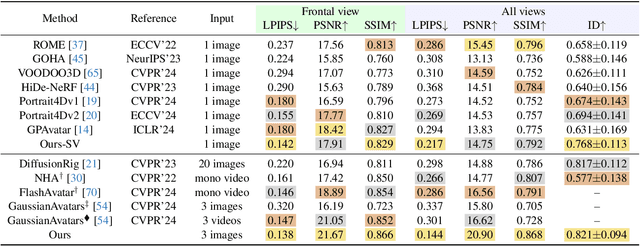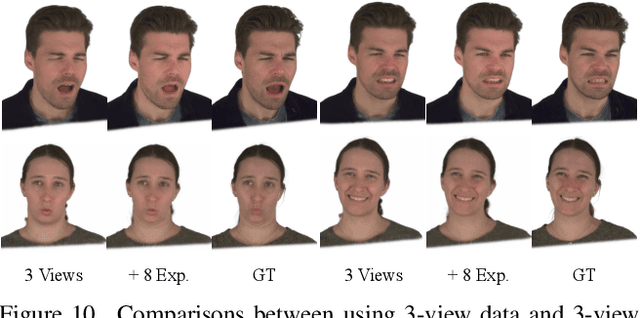Weiyi Zhang
Department of Computer Science and Technology, Tsinghua University, Beijing, China
FFA Sora, video generation as fundus fluorescein angiography simulator
Dec 23, 2024Abstract:Fundus fluorescein angiography (FFA) is critical for diagnosing retinal vascular diseases, but beginners often struggle with image interpretation. This study develops FFA Sora, a text-to-video model that converts FFA reports into dynamic videos via a Wavelet-Flow Variational Autoencoder (WF-VAE) and a diffusion transformer (DiT). Trained on an anonymized dataset, FFA Sora accurately simulates disease features from the input text, as confirmed by objective metrics: Frechet Video Distance (FVD) = 329.78, Learned Perceptual Image Patch Similarity (LPIPS) = 0.48, and Visual-question-answering Score (VQAScore) = 0.61. Specific evaluations showed acceptable alignment between the generated videos and textual prompts, with BERTScore of 0.35. Additionally, the model demonstrated strong privacy-preserving performance in retrieval evaluations, achieving an average Recall@K of 0.073. Human assessments indicated satisfactory visual quality, with an average score of 1.570(scale: 1 = best, 5 = worst). This model addresses privacy concerns associated with sharing large-scale FFA data and enhances medical education.
EyeDiff: text-to-image diffusion model improves rare eye disease diagnosis
Nov 15, 2024Abstract:The rising prevalence of vision-threatening retinal diseases poses a significant burden on the global healthcare systems. Deep learning (DL) offers a promising solution for automatic disease screening but demands substantial data. Collecting and labeling large volumes of ophthalmic images across various modalities encounters several real-world challenges, especially for rare diseases. Here, we introduce EyeDiff, a text-to-image model designed to generate multimodal ophthalmic images from natural language prompts and evaluate its applicability in diagnosing common and rare diseases. EyeDiff is trained on eight large-scale datasets using the advanced latent diffusion model, covering 14 ophthalmic image modalities and over 80 ocular diseases, and is adapted to ten multi-country external datasets. The generated images accurately capture essential lesional characteristics, achieving high alignment with text prompts as evaluated by objective metrics and human experts. Furthermore, integrating generated images significantly enhances the accuracy of detecting minority classes and rare eye diseases, surpassing traditional oversampling methods in addressing data imbalance. EyeDiff effectively tackles the issue of data imbalance and insufficiency typically encountered in rare diseases and addresses the challenges of collecting large-scale annotated images, offering a transformative solution to enhance the development of expert-level diseases diagnosis models in ophthalmic field.
MiniTac: An Ultra-Compact 8 mm Vision-Based Tactile Sensor for Enhanced Palpation in Robot-Assisted Minimally Invasive Surgery
Oct 30, 2024Abstract:Robot-assisted minimally invasive surgery (RAMIS) provides substantial benefits over traditional open and laparoscopic methods. However, a significant limitation of RAMIS is the surgeon's inability to palpate tissues, a crucial technique for examining tissue properties and detecting abnormalities, restricting the widespread adoption of RAMIS. To overcome this obstacle, we introduce MiniTac, a novel vision-based tactile sensor with an ultra-compact cross-sectional diameter of 8 mm, designed for seamless integration into mainstream RAMIS devices, particularly the Da Vinci surgical systems. MiniTac features a novel mechanoresponsive photonic elastomer membrane that changes color distribution under varying contact pressures. This color change is captured by an embedded miniature camera, allowing MiniTac to detect tumors both on the tissue surface and in deeper layers typically obscured from endoscopic view. MiniTac's efficacy has been rigorously tested on both phantoms and ex-vivo tissues. By leveraging advanced mechanoresponsive photonic materials, MiniTac represents a significant advancement in integrating tactile sensing into RAMIS, potentially expanding its applicability to a wider array of clinical scenarios that currently rely on traditional surgical approaches.
Visual Question Answering in Ophthalmology: A Progressive and Practical Perspective
Oct 22, 2024

Abstract:Accurate diagnosis of ophthalmic diseases relies heavily on the interpretation of multimodal ophthalmic images, a process often time-consuming and expertise-dependent. Visual Question Answering (VQA) presents a potential interdisciplinary solution by merging computer vision and natural language processing to comprehend and respond to queries about medical images. This review article explores the recent advancements and future prospects of VQA in ophthalmology from both theoretical and practical perspectives, aiming to provide eye care professionals with a deeper understanding and tools for leveraging the underlying models. Additionally, we discuss the promising trend of large language models (LLM) in enhancing various components of the VQA framework to adapt to multimodal ophthalmic tasks. Despite the promising outlook, ophthalmic VQA still faces several challenges, including the scarcity of annotated multimodal image datasets, the necessity of comprehensive and unified evaluation methods, and the obstacles to achieving effective real-world applications. This article highlights these challenges and clarifies future directions for advancing ophthalmic VQA with LLMs. The development of LLM-based ophthalmic VQA systems calls for collaborative efforts between medical professionals and AI experts to overcome existing obstacles and advance the diagnosis and care of eye diseases.
Fundus to Fluorescein Angiography Video Generation as a Retinal Generative Foundation Model
Oct 17, 2024Abstract:Fundus fluorescein angiography (FFA) is crucial for diagnosing and monitoring retinal vascular issues but is limited by its invasive nature and restricted accessibility compared to color fundus (CF) imaging. Existing methods that convert CF images to FFA are confined to static image generation, missing the dynamic lesional changes. We introduce Fundus2Video, an autoregressive generative adversarial network (GAN) model that generates dynamic FFA videos from single CF images. Fundus2Video excels in video generation, achieving an FVD of 1497.12 and a PSNR of 11.77. Clinical experts have validated the fidelity of the generated videos. Additionally, the model's generator demonstrates remarkable downstream transferability across ten external public datasets, including blood vessel segmentation, retinal disease diagnosis, systemic disease prediction, and multimodal retrieval, showcasing impressive zero-shot and few-shot capabilities. These findings position Fundus2Video as a powerful, non-invasive alternative to FFA exams and a versatile retinal generative foundation model that captures both static and temporal retinal features, enabling the representation of complex inter-modality relationships.
EyeCLIP: A visual-language foundation model for multi-modal ophthalmic image analysis
Sep 10, 2024Abstract:Early detection of eye diseases like glaucoma, macular degeneration, and diabetic retinopathy is crucial for preventing vision loss. While artificial intelligence (AI) foundation models hold significant promise for addressing these challenges, existing ophthalmic foundation models primarily focus on a single modality, whereas diagnosing eye diseases requires multiple modalities. A critical yet often overlooked aspect is harnessing the multi-view information across various modalities for the same patient. Additionally, due to the long-tail nature of ophthalmic diseases, standard fully supervised or unsupervised learning approaches often struggle. Therefore, it is essential to integrate clinical text to capture a broader spectrum of diseases. We propose EyeCLIP, a visual-language foundation model developed using over 2.77 million multi-modal ophthalmology images with partial text data. To fully leverage the large multi-modal unlabeled and labeled data, we introduced a pretraining strategy that combines self-supervised reconstructions, multi-modal image contrastive learning, and image-text contrastive learning to learn a shared representation of multiple modalities. Through evaluation using 14 benchmark datasets, EyeCLIP can be transferred to a wide range of downstream tasks involving ocular and systemic diseases, achieving state-of-the-art performance in disease classification, visual question answering, and cross-modal retrieval. EyeCLIP represents a significant advancement over previous methods, especially showcasing few-shot, even zero-shot capabilities in real-world long-tail scenarios.
UWF-RI2FA: Generating Multi-frame Ultrawide-field Fluorescein Angiography from Ultrawide-field Retinal Imaging Improves Diabetic Retinopathy Stratification
Aug 27, 2024



Abstract:Ultrawide-field fluorescein angiography (UWF-FA) facilitates diabetic retinopathy (DR) detection by providing a clear visualization of peripheral retinal lesions. However, the intravenous dye injection with potential risks hamper its application. We aim to acquire dye-free UWF-FA images from noninvasive UWF retinal imaging (UWF-RI) using generative artificial intelligence (GenAI) and evaluate its effectiveness in DR screening. A total of 18,321 UWF-FA images of different phases were registered with corresponding UWF-RI images and fed into a generative adversarial networks (GAN)-based model for training. The quality of generated UWF-FA images was evaluated through quantitative metrics and human evaluation. The DeepDRiD dataset was used to externally assess the contribution of generated UWF-FA images to DR classification, using area under the receiver operating characteristic curve (AUROC) as outcome metrics. The generated early, mid, and late phase UWF-FA images achieved high authenticity, with multi-scale similarity scores ranging from 0.70 to 0.91 and qualitative visual scores ranging from 1.64 to 1.98 (1=real UWF-FA quality). In fifty randomly selected images, 56% to 76% of the generated images were difficult to distinguish from real images in the Turing test. Moreover, adding these generated UWF-FA images for DR classification significantly increased the AUROC from 0.869 to 0.904 compared to the baseline model using UWF-RI images (P < .001). The model successfully generates realistic multi-frame UWF-FA images for enhancing DR stratification without intravenous dye injection.
Fundus2Video: Cross-Modal Angiography Video Generation from Static Fundus Photography with Clinical Knowledge Guidance
Aug 27, 2024



Abstract:Fundus Fluorescein Angiography (FFA) is a critical tool for assessing retinal vascular dynamics and aiding in the diagnosis of eye diseases. However, its invasive nature and less accessibility compared to Color Fundus (CF) images pose significant challenges. Current CF to FFA translation methods are limited to static generation. In this work, we pioneer dynamic FFA video generation from static CF images. We introduce an autoregressive GAN for smooth, memory-saving frame-by-frame FFA synthesis. To enhance the focus on dynamic lesion changes in FFA regions, we design a knowledge mask based on clinical experience. Leveraging this mask, our approach integrates innovative knowledge mask-guided techniques, including knowledge-boosted attention, knowledge-aware discriminators, and mask-enhanced patchNCE loss, aimed at refining generation in critical areas and addressing the pixel misalignment challenge. Our method achieves the best FVD of 1503.21 and PSNR of 11.81 compared to other common video generation approaches. Human assessment by an ophthalmologist confirms its high generation quality. Notably, our knowledge mask surpasses supervised lesion segmentation masks, offering a promising non-invasive alternative to traditional FFA for research and clinical applications. The code is available at https://github.com/Michi-3000/Fundus2Video.
Generating Multi-frame Ultrawide-field Fluorescein Angiography from Ultrawide-field Color Imaging Improves Diabetic Retinopathy Stratification
Aug 20, 2024



Abstract:Ultrawide-field fluorescein angiography (UWF-FA) facilitates diabetic retinopathy (DR) detection by providing a clear visualization of peripheral retinal lesions. However, the intravenous dye injection with potential risks hamper its application. We aim to acquire dye-free UWF-FA images from noninvasive UWF color fundus (UWF-CF) images using generative artificial intelligence (GenAI) and evaluate its effectiveness in DR screening. A total of 18,321 UWF-FA images of different phases were registered with corresponding UWF-CF images and fed into a generative adversarial networks (GAN)-based model for training. The quality of generated UWF-FA images was evaluated through quantitative metrics and human evaluation. The DeepDRiD dataset was used to externally assess the contribution of generated UWF-FA images to DR classification, using area under the receiver operating characteristic curve (AUROC) as outcome metrics. The generated early, mid, and late phase UWF-FA images achieved high authenticity, with multi-scale similarity scores ranging from 0.70 to 0.91 and qualitative visual scores ranging from 1.64 to 1.98 (1=real UWF-FA quality). In fifty randomly selected images, 56% to 76% of the generated images were difficult to distinguish from real images in the Turing test. Moreover, adding these generated UWF-FA images for DR classification significantly increased the AUROC from 0.869 to 0.904 compared to the baseline model using UWF-CF images (P < .001). The model successfully generates realistic multi-frame UWF-FA images without intravenous dye injection. The generated UWF-FA enhanced DR stratification.
HeadGAP: Few-shot 3D Head Avatar via Generalizable Gaussian Priors
Aug 12, 2024



Abstract:In this paper, we present a novel 3D head avatar creation approach capable of generalizing from few-shot in-the-wild data with high-fidelity and animatable robustness. Given the underconstrained nature of this problem, incorporating prior knowledge is essential. Therefore, we propose a framework comprising prior learning and avatar creation phases. The prior learning phase leverages 3D head priors derived from a large-scale multi-view dynamic dataset, and the avatar creation phase applies these priors for few-shot personalization. Our approach effectively captures these priors by utilizing a Gaussian Splatting-based auto-decoder network with part-based dynamic modeling. Our method employs identity-shared encoding with personalized latent codes for individual identities to learn the attributes of Gaussian primitives. During the avatar creation phase, we achieve fast head avatar personalization by leveraging inversion and fine-tuning strategies. Extensive experiments demonstrate that our model effectively exploits head priors and successfully generalizes them to few-shot personalization, achieving photo-realistic rendering quality, multi-view consistency, and stable animation.
 Add to Chrome
Add to Chrome Add to Firefox
Add to Firefox Add to Edge
Add to Edge